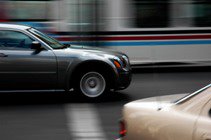Beyond The Simple GPS Navigator
 Joel Arellano sounds confident in his post to Autoblog titled, "GPS won't replace common sense, maps." But the competitors in The Grand Challenge have other ideas about the potential for computer-aided navigation.
Joel Arellano sounds confident in his post to Autoblog titled, "GPS won't replace common sense, maps." But the competitors in The Grand Challenge have other ideas about the potential for computer-aided navigation.A Very Different Sort Of Race
As Scientific American reports, the contest, which was sponsored by the U.S. Defense Department, was a 132-mile race for driverless vehicles. Held in the Mojave Desert in March 2004, it featured a prize of $2 million for the winner.
Five autonomous vehicles finished the course, four of them navigating the 132-mile course in less than the 10 hours required to be eligible for the prize. These are not remote-controlled cars, these are cars, and some trucks, that actually drive themselves, steering their course with on-board computers.
GPS Plus
Not surprisingly, every contestant in the Grand Challenge was equipped with differential GPS receivers, but most teams added other tracking systems to their robots, typically inertial navigation systems.
However, two of the teams created technologies that look promising:
- A team of high school students from Palos Verdes, California installed a bright lamp in their robot and directed the light onto the ground. A camera aimed at the bright spot picks up motion in any horizontal direction, acting as a two-dimensional odometer. The team called their system, "The GroundMouse."
- A team of professional engineers from Ford, Honeywell, Delphi and Perceptek, used a similar technique on their pickup truck. A radar aimed at the ground senses Doppler shifts in the frequency of the reflected beam. The robot then calculates relative motion so that when the it loses the GPS fix on its location it can fall back on dead-reckoning navigation from its radar odometer.
But it's not enough to plot a course from Point A to Point B. To be truly "driverless" a vehicle has to be able to adapt to road conditions. To accomplish this, the teams used laser scanners. By sweeping an infrared laser beam in front of the vehicle, the scanner creates a three-dimensional image of the road ahead. The teams used various configurations of laser scanners to help their robot, "see" the road ahead.
Winning Technology
The competition, and the $2 million was won by a team from Stanford. The differenc for the Stanford team was its vision-based speed switch. That simple tool allowed the robot to speed up whenever it saw a smooth stretch of road in front of it. However, some of the most promising technology appeared on vehicles that failed to finish.
Since the vehicles didn't actually drive themselves solely with GPS, Mr. Arellano is technically correct. But with strong military and commercial interest in the technologies that were developed, it looks like many of the teams will go full speed ahead.




<< Home